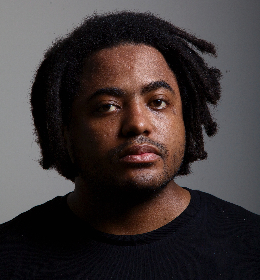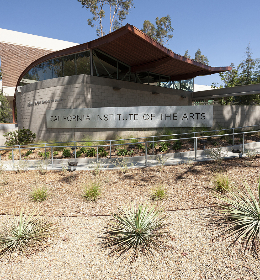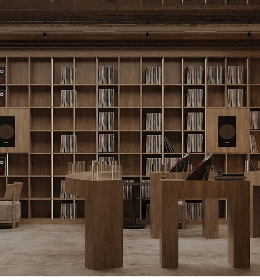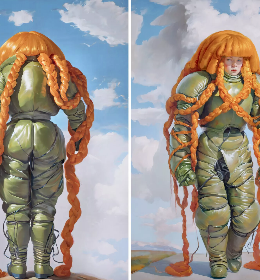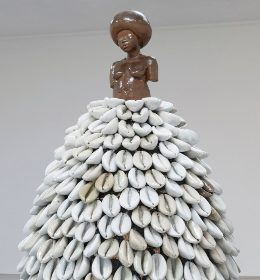In the 8th arrondissement of Paris, this idea of an exhibition that combines works from different periods has existed for a long time. This idea is also mentioned in Bataille's Critical Dictionary, published in 1929 in the magazine titled Documents.
The Georges Bataille Dictionary doesn't intend to provide definitions, but to tell stories and open perspectives. The exhibition, curated by Serena Cattaneo, aims to create a new point of view for the visitor. Within the exhibition, spontaneous links appear and reveal unexpected aspects of the works. It creates curiosity and a desire to explore the depths of the artist's work, their vision and the echo of the work at the time of its completion.
Creating the link
Mary Weatherford, born in 1963 - who recently joined the gallery - has studied illuminations extensively. In response to an illuminated manuscript of the 15th century, the American artist has created a more "calligraphic" piece than she usually does.
The next dialogue is between a piece by Donald Judd and a painting by Guido Reni (1575-1642). The association between the painter - who studied at the school of Bologna and very good colorist - and the minimalist artist appears to be based around a call to spirituality and the color red.

Donald Judd, Untitled (1991) | Guido Reni, Saint Jérôme, c. 1605 - 1610 — © 2018 Judd Foundation / Artists Rights Society (ARS), New York. Photography by Thomas Lannes. Courtesy Gagosian.
The American painter Joe Bradley, whose work is influenced by African art, has been chosen to be displayed alongside a ritual clan sculpture from Togo, made around 1900.

Joe Bradley, Real Goon (2017) | Clan shrine figure, Tchitcheri Sakwa (Togo), c. 1900 — © Joe Bradley. Photography by Thomas Lannes. Courtesy Gagosian
Further on, a 1929 Kandinsky from his Bauhaus period interacts with a hyper-realistic Duane Hanson sculpture from 1990, showing an archetypal image of an American student. Here the "frontal" opposition creates the link.

Wassily Kandinsky, Dicht (1929) | Duane Hanson, High School Student (1990) — © 2018 C. Herscovici / Artists Rights Society (ARS), New York. © Adagp, Paris, [2018]. Photography by Thomas Lannes. Courtesy Gagosian.
Elsewhere, form is the basis of the association. A monumental marble sculpture by Louise Bourgeois, from the beginning of the 1990s, exploring the themes of "domesticity, death, sexuality and the body" is combined with a sublime work by Alberto Burri. Powerful and intimate, the work of Louise Bourgeois contains "a perfectly polished orb" while that of Burri has three holes, the "results of burning", dug in the red plastic.

Louise Bourgeois, Cleavage (1991) | Alberto Burri, Rosso Plastica (1968) — © The Easton Foundation / Adagp, Paris [2018]. © Adagp, Paris, [2018]. Photography by Thomas Lannes. Courtesy Gagosian.
The following relationship is more obvious. A singular work by Anish Kapoor: the artist - who had made a series of Alabaster pieces in the 1990s - produced in 2016, Chamber 3, where three round shapes carved into the block are covered in gold leaf “suggesting an alchemical transformation”. Next to it, a fifteenth century illumination by Paolo Schiavo - with a golden background...
However, it is towards the end of the exhibition that the dialogue of where the idea came from is presented to the visitor : a sublime and impressive classical sculpture faces an American abstract painting by Frank Stella. As Edouard Pradère explains, these are "two visions of beauty, very representative of their times. Stella's is a vision that is perfect in terms of form and color, the artistic idea of looking for something perfect". The dialogue therefore concerns what the two works represented in their respective eras; it's a spatio-temporal journey.
Finally, a neon work by Dan Flavin is presented next to a 1990s painting by Helen Frankenthaler. The reflection of the neon is reflected in the painting. The dialogue here comes from the projected color. Even if violet links the two pieces, and they were produced at the same time, the approaches are extremely different.
Until July 30, the Gagosian Gallery decompartmentalizes the history of art. It is an exhibition on a museum level - it's innovative. And if one wishes to have the opportunity to discover more offerings such as this one, few galleries have the capacity to gather works of this standard, essential to such an ambitious project.
Henri Robert





